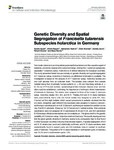Genetic Diversity and Spatial Segregation of Francisella tularensis Subspecies holarctica in Germany
Appelt, Sandra
Köppen, Kristin
Radonić, Aleksandar
Drechsel, Oliver
Jacob, Daniela
Grunow, Roland
Heuner, Klaus
Francisella tularensis is an intracellular pleomorphic bacterium and the causative agent of tularemia, a zoonotic disease with a wide host range. Among the F. tularensis subspecies, especially F. tularensis subsp. holarctica is of clinical relevance for European countries. The study presented herein focuses namely on genetic diversity and spatial segregation of F. tularensis subsp. holarctica in Germany, as still limited information is available. The investigation is based on the analysis of 34 F. tularensis subsp. holarctica isolates and one draft genome from an outbreak strain. The isolates were cultured from sample material being that of primarily human patients (n = 25) and free-living animals (n = 9). For six of 25 human isolates, epidemiological links between disease onset and tick bites could be established, confirming the importance of arthropod linked transmission of tularemia in Germany. The strains were assigned to three of four major F. tularensis subsp. holarctica clades: B.4, B.6, and B.12. Thereby, B.6 and B.12 clade members were predominantly found; only one human isolate was assigned to clade B.4. Also, it turned out that eight isolates which caused pneumonia in patients clustered into the B.6 clade. Altogether, eight different final subclades were assigned to clade B.6 (biovar I, erythromycin sensitive) and six to B.12 (biovar II, erythromycin resistant) in addition to one new final B.12 subclade. Moreover, for 13 human and 3 animal isolates, final subclade subdivisions were not assigned (B.12 subdivisions B.33 and B.34, and B.6 subdivision B.45) because official nomenclatures are not available yet. This gives credit to the genetic variability of F. tularensis subsp. holarctica strains in Germany. The results clearly point out that the given genetic diversity in Germany seems to be comparably high to that found in other European countries including Scandinavian regions. A spatial segregation of B.6 and B.12 strains was found and statistically confirmed, and B.12 clade members were predominantly found in eastern parts and B.6 members more in western to southern parts of Germany. The portion of B.12 clade members in northeastern parts of Germany was 78.5% and in southwestern parts 1.9%.
Dateien zu dieser Publikation

